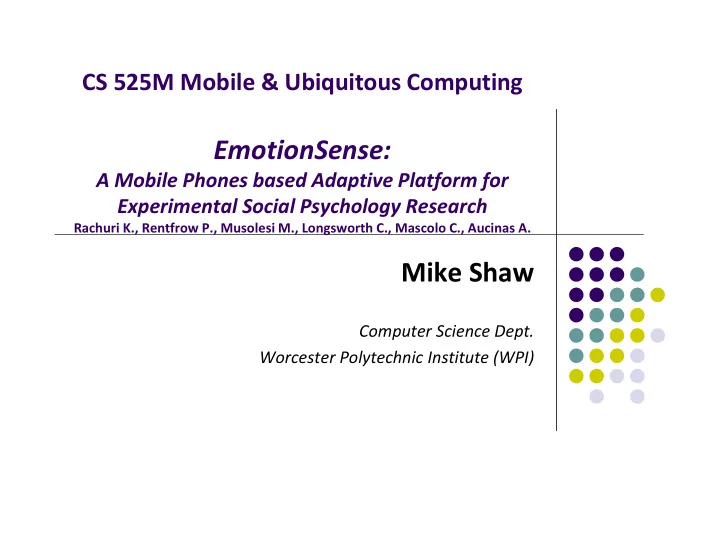

CS 525M Mobile & Ubiquitous Computing EmotionSense: A Mobile Phones based Adaptive Platform for Experimental Social Psychology Research Rachuri K., Rentfrow P., Musolesi M., Longsworth C., Mascolo C., Aucinas A. Mike Shaw Computer Science Dept. Worcester Polytechnic Institute (WPI)
OUTLINE Motivation Related work Goal Assumptions & limitations Methodology Benchmarking Results Future work 2
MOTIVATION Study emotions and the relationship to environment Provide mental health and social science experts with – Emotional factors with respect to interpersonal relationships Identify locations and emotional responses Evaluate activity vs. emotions Smartphones allow field study w/o specialized equipment Past: In ‐ home cameras, attached mics & diaries = Biased results Today: Ubiquity of smartphones desensitizes users from monitoring activities 3
RELATED WORK Location and activity correlation BeTelGeuse [2] open source framework to gather situational information CenseMe [4] detects activity at a location (e.g., dancing w/friends) and reports activity to social media Social science experimentation Environmental activated recorder (EAR) to evaluate sociability contexts [3] Self ‐ reporting Use smartphone to report moods throughout the day to suggest therapy options [5] 4
GOAL “The overarching goal of EmotionSense is to exploit mobile sensing technology to study human social behavior.” Evaluate people’s emotions using smartphone sensors and speech ‐ recognition tools to observe behavior patterns in social situations 5
ASSUMPTIONS & LIMITATIONS Assumptions Participants will have smartphone with them majority of the time Microphone is unobstructed Participants gather frequently HTK produces correct results (before and after porting to Symbian) Limitations How well the participants represent persons who exhibit a wide range of detectable emotions How well the training data represents emotional signatures 6
METHODOLOGY Information flow Speaker recognition Based on Gaussian Mixture Model (GMM) & Maximum A Posteriori (MAP) adaptation Windows/Linux toolkit ported to Symbian OS Emotion recognition Also based on Gaussian Mixture Model Narrow emotional types are clustered into a broad classifications Adaptation framework Generate rules to govern sensor sampling rates 7
Information Flow Sensor Monitors/Classifier Knowledge Base Movement detection Converts sensor data into facts Bluetooth proximity detection fact(<fact_name>, <value>) Ex: GPS monitor fact(Activity, 1) Action Base Interference Engine Stores actionable events Sensor sampling rate adaptation fact(`action’, <action_name>, Preservation of battery <value>) Sample thresholds to minimize Ex: lossiness fact(`action’, `ActivitySampling Interval’, 10) EmotionSense Manager Starts all sensor monitor threads Instantiates Knowledge Base Invokes Inference Engine for fact collection 8
Speaker Recognition Apply GMM to distinguish Audio Data Collection study participants from & Parameterization others Audio sequences are MAP is applied to derive assigned user user ‐ specific GMMs probabilities at run ‐ time 9
Emotion Recognition Similar method as speaker recognition GMM trained on Emotional Prosody Speech and Transcripts library to classify emotions MAP adaptation is used to generate user specific models Emotional characteristics are assigned to audio sequences Emotion clustering Emotion grouping used by social psychologists Narrow emotion classification difficult even for humans 10
BENCHMARKS Micro ‐ benchmarks to evaluated system performance Adaptation rules were collected from 12 users in a 24hr period Tuned framework based on the Nokia’s 6210 sensor data captures Speaker recognition 10min of training data from 10 users Sample lengths varied from 1 to 15 seconds 90% accuracy with sample lengths greater than 4 seconds Emotion recognition Use pre ‐ existing test and training library 350 test samples per ‐ sample length second ~70% accuracy with sample lengths greater than 5 seconds 11
Benchmarks Recognition accuracy & latency Speaker recognition accuracy vs. audio sample Speaker recognition latency vs. audio sample length length Convergence ~90% > 4 seconds Local benchmark based on 369MHz ARM 11 µP 12
Benchmarks Power Consumption Energy consumption vs. audio sample length Energy consumption vs. maximum sampling interval 13
Benchmarks Confusion Matrix 14
RESULTS Trial conducted for 10 days with 18 participants Participant daily diaries Activities Who was present Mood Location Emotion Distribution Neutral emotions are the most prevalent Fear is the least prevent 15
Results Emotion Distribution Distribution of detected broad emotions Distribution of detected broad emotions with respect to time of day Most social activity exhibits Emotions are more prevalent as neutral emotions the day progresses 16
Results Emotion Distribution Distribution of detected broad emotions within Distribution of detected broad emotions with physical state respect to number of co-located participants Non ‐ neutral emotions are more Why is sadness experience in prevalent in the idle state groups? 17
CONCLUSIONS Demonstrated smartphones are a viable tool for social science research Able to identify (to some degree) participant's emotions through speech recognition A majority of speech is categorized as neutral Emotion categorization algorithm produced underwhelming results 18
FUTURE WORK Galvanic skin response sensor Continue optimizing emotional recognition model Addition of more realistic noise models Real ‐ time feedback, daily monitoring and user interaction options 19
References 1. J. Froehlich, M. Y. Chen, S. Consolvo, B. Harrison, and J. A. Landay. MyExperience: A System for In situ Tracing and Capturing of User Feedback on Mobile Phones. In Proceedings of MobiSys ’07 , pages 57–70, 2007. 2. J. Kukkonen, E. Lagerspetz, P. Nurmi, and M. Andersson. BeTelGeuse: A Platform for Gathering and Processing Situational Data. IEEE Pervasive Computing, 8(2): 49–56, 2009. 3. M. R. Mehl, S. D. Gosling, and J. W. Pennebaker. Personality in Its Natural Habitat: Manifestations and Implicit Folk Theories of Personality in Daily Life. Journal of Personality and Social Psychology, 90(5): 862–877, 2006. 4. E. Miluzzo, N. D. Lane, K. Fodor, R. Peterson, H. Lu, M. Musolesi, S. B. Eisenman, X. Zheng, and A. T. Campbell. Sensing Meets Mobile Social Networks: The Design, Implementation and Evaluation of the CenceMe Application. In Proceedings of SenSys ’08 , pages 337–350, 2008 5. E. M. Morris, Q. Kathawala, K. T. Leen, E. E. Gorenstein, F. Guilak, M. Labhard, and W. Deleeuw. Mobile Therapy: Case Study Evaluations of a Cell Phone Application for Emotional Self- Awareness. Journal of Medical Internet Research, 12(2):e10 , 2010. 6. A. S. Pentland. Honest Signals: How They Shape Our World. The MIT Press , 2008. 7. Allilli M. A Short Tutorial on Gaussian Mixture Models. Université du Québec en Outaouais , 2010. 20
Recommend
More recommend